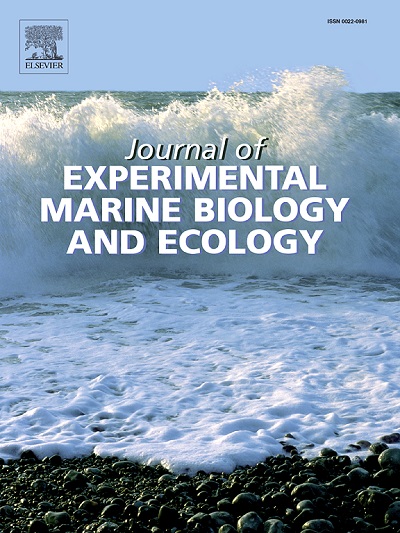Lack of root oxygen loss from the dominant tropical Atlantic-Caribbean seagrass, Thalassia testudinum, in a highly sulfidic carbonate lagoon
IF 1.8
3区 生物学
Q3 ECOLOGY
Journal of Experimental Marine Biology and Ecology
Pub Date : 2025-05-27
DOI:10.1016/j.jembe.2025.152113
引用次数: 0
Abstract
Although seagrasses transport leaf and water column oxygen (O2) to belowground rhizome and root tissues, mortality events from hypoxia-driven H2S intrusion occur, resulting in large-scale seagrass mortality events worldwide and in Florida Bay (40 km2), a large (2200 km2) seagrass-dominated estuary at the terminus of the Florida (USA) Peninsula. We examined the dominant tropical Atlantic-Caribbean seagrass Thalassia testudinum's ability to transport O2 to belowground tissues and diffuse O2 into root rhizospheres to constrain H2S diffusion into roots. We examined O2 in the rhizosphere in the light and dark by deploying 2-D planar O2 optode sensors and measured pO2 and H2S dynamics in rhizospheres using microsensors. Our planar optode experiments revealed no detectable root O2 loss (ROL) to rhizospheres which remained anoxic in >9 h of light (500 μmol photons m−2 s−1). Sediment O2 and H2S microsensor profiles of the rhizosphere and light/dark gas dynamic studies revealed that rhizospheres remained anoxic and H2S concentrations reached ∼200 μM in the light and dark. At the same time, belowground tissue internal pO2 was above air saturation (>21 kPa) in the light (3−12h) and remained oxic in the dark (12h) with no detectable H2S intrusion. The lack of oxic regions in rhizospheres under high internal tissue pO2 indicate a restriction of ROL in this slow-growing species. A limitation of root-sediment gas exchange in T. testudinum may be an evolutionary strategy to prevent O2 loss along deep roots and minimize H2S intrusion in sulfidic carbonate sediments.
在高硫化物碳酸盐泻湖中,主要的热带大西洋-加勒比海草,海草海草缺乏根氧损失
虽然海草将叶片和水柱氧气(O2)输送到地下根茎和根组织,但缺氧驱动的H2S入侵导致了大规模的海草死亡事件,导致世界范围内和佛罗里达湾(40平方公里)发生了大规模的海草死亡事件,佛罗里达湾是佛罗里达州(美国)半岛末端的一个大型(2200平方公里)海草为主的河口。我们研究了占优势的热带大西洋-加勒比海草海草(Thalassia testudinum)将O2运输到地下组织并将O2扩散到根际以限制H2S向根内扩散的能力。我们通过部署二维平面O2光电传感器检测了光照和黑暗条件下根际中的O2,并使用微传感器测量了根际中pO2和H2S的动态。我们的平面光电实验显示,在500 μmol光子m−2 s−1的光照条件下,根际没有可检测到的缺氧根O2损失(ROL)。根际沉积物O2和H2S微传感器剖面和光/暗气体动态研究表明,根际在光照和黑暗条件下保持缺氧状态,H2S浓度达到~ 200 μM。同时,在光照条件下(3 ~ 12h),地下组织内部pO2高于空气饱和度(21 kPa),在黑暗条件下(12h), pO2为含氧状态,H2S未被检测到。在高组织内部pO2的情况下,根际缺乏氧区表明这种生长缓慢的物种的ROL受到限制。限制龙舌龙根-沉积物气体交换可能是一种进化策略,以防止根深O2损失和减少硫化氢碳酸盐沉积物中H2S的侵入。
本文章由计算机程序翻译,如有差异,请以英文原文为准。
求助全文
约1分钟内获得全文
求助全文
来源期刊
CiteScore
4.30
自引率
0.00%
发文量
98
审稿时长
14 weeks
期刊介绍:
The Journal of Experimental Marine Biology and Ecology provides a forum for experimental ecological research on marine organisms in relation to their environment. Topic areas include studies that focus on biochemistry, physiology, behavior, genetics, and ecological theory. The main emphasis of the Journal lies in hypothesis driven experimental work, both from the laboratory and the field. Natural experiments or descriptive studies that elucidate fundamental ecological processes are welcome. Submissions should have a broad ecological framework beyond the specific study organism or geographic region.
Short communications that highlight emerging issues and exciting discoveries within five printed pages will receive a rapid turnaround. Papers describing important new analytical, computational, experimental and theoretical techniques and methods are encouraged and will be highlighted as Methodological Advances. We welcome proposals for Review Papers synthesizing a specific field within marine ecology. Finally, the journal aims to publish Special Issues at regular intervals synthesizing a particular field of marine science. All printed papers undergo a peer review process before being accepted and will receive a first decision within three months.

 求助内容:
求助内容: 应助结果提醒方式:
应助结果提醒方式:


